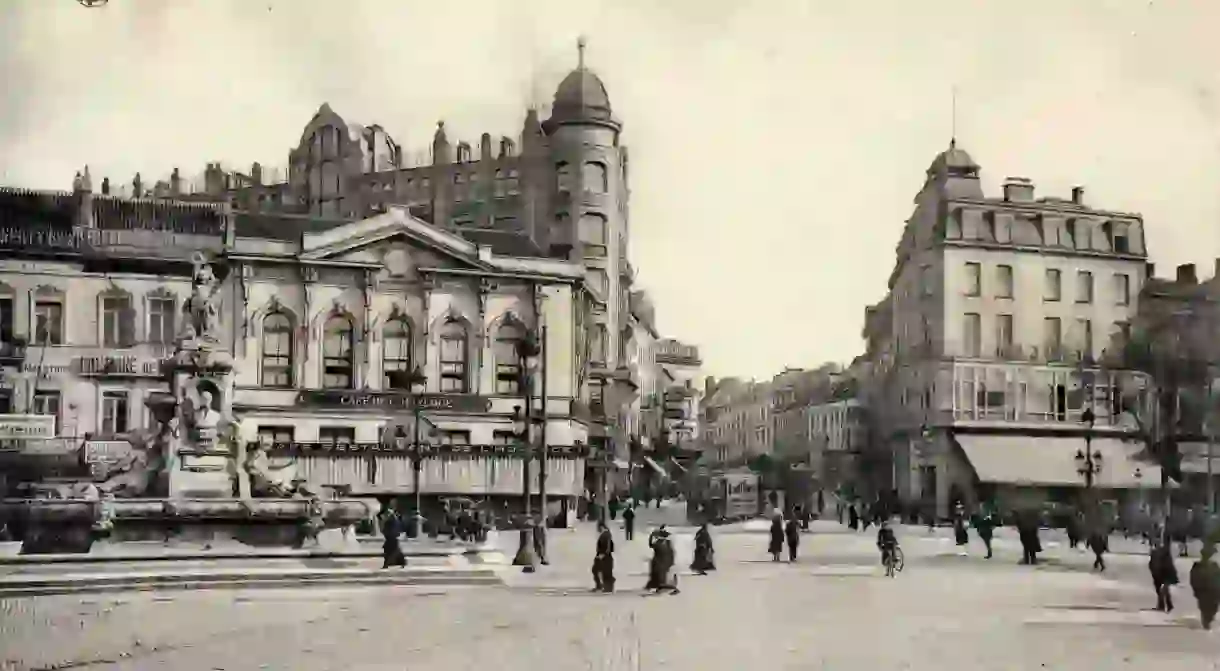Then and Now: Can You Recognise Brussels from These Old Pictures?

By the late 1800s and early 1900s, Brussels found itself the imposing capital of fresh-faced Belgium, rife with monumental landmarks in neo-styles that were ordered by ‘Builder King’ Leopold II to inject his new nation with the necessary prestige. While some of these structures disappeared without a trace, others persisted as gleaming high-risers and even a European Parliament sprung up around them. As seen in these then-and-now shots, the result is a metropolis straddling past and present.
Place de Brouckère c.1913
By the early 1900s, the Place de Brouckère, built as part of the enclosure of the old river Senne, had flourished into one of Brussels’ beating hearts. Jacques Brel sang about the ‘men and women in crinoline’ and in ‘top hats’ it attracted during the days of the Belle Époque in his spirited chanson Bruxelles, and architecture-wise the prestigious plaza wore a fin-de-siècle jacket.
Today, a fair part of these eye-catching structures, such as the iconic Hotel Métropole, remain, while other sizeable, more modern buildings nestled themselves between them during the ’70s. In its glory days, Brouckère was on a par with New York’s Times Square, but with the arrival of the car, the space has changed in terms of pedestrian space and how much of it there should be.

Place de Brouckère today

North Station and Place Rogier c. early 1900s
Home to a major railway hub back then, the Place Rogier looks very different today. The original station, pictured left on the old postcard below, has been demolished and a new one was erected five minutes’ walk away. Place Rogier itself has undergone a massive transformation in the recent decade, with a new, white canopy in steel dominating its appearance. To complete the contemporary feel, a Starbucks has taken up residence inside the structure’s slick-looking pedestal.

Place Rogier today

Covering of the Senne river c.1867
The most drastic surgery on Brussels’ streetscape came in the late 1860s and early 1870s, when the Senne river – the banks of which the city sprang to life on – was covered up almost entirely and the construction works took down the surrounding poorer neighbourhoods with it. The dirtied river that had become known as ‘Brussels’ open-air sewer’ and had sparked a cholera outbreak had become a thorn in the side of then-mayor Jules Anspach.
In its place came wide boulevards emulating those of Paris, and monumental public buildings. The banishment of the Senne underground didn’t sit right with a large part of the population however, and Anspach, who gave his name to one of the new avenues, faced fierce criticism for burying ‘Old Brussels’ with bad urban planning. Whichever way you look at it, the changes made during these years define the layout of downtown Brussels today.

Boulevard Anspach, part of the covered Senne river area, today

Place du Luxembourg in the early 1900s
Known today for its upscale cafés and steady stream of eurocrats filtering in and out of the European Parliament, the Place du Luxembourg started off as a principal part of the Leopold Quarter and its prosperous residential areas. Named after the railway station that connected the Belgian capital to its neighbour Luxembourg, only the station’s historic façade is left standing today, but from behind its old clock, the glass bow of a modern institutional mastodon peeks out.
In one of Brussels’ most striking old-and-new combos, the monument’s front has been incorporated in the design for the building we can call the political heart of Europe. In the second photo, students can be seen observing the nifty architectural blend ahead of a tour of Parliament.

Place du Luxembourg today

Le Botanique between 1829 and 1860
An almost 200-year old green oasis in the city, Le Botanique – currently a cultural centre and original concert venue with lush gardens – started off life in the 1820s as the Royal Society of Horticulture, where the plant-loving elite kept their exotic greeneries. In this painted rendering by Belgian lithographer Henri Borremans, the landscaped gardens were clearly still used exclusively by the local bourgeoisie.
As calls for a more inclusive function of the marvellous glass building became louder, it was renamed the National Botanic Garden of Belgium, and again changed roles in the 1980s to become an eclectic concert hub. To date, the venue’s grand orangerie and beautiful gardens live on, surrounded now by traffic lanes and glistening high-risers.

Le Botanique today

Porte de Namur c.1900
As a tangible example of how mankind’s transportation methods have evolved, the Porte de Namur on the city’s small ring is a whopper! Once resounding with the clanging bells of tram trolleys and the click-clack of horseshoes on cobblestones, its dominant sound is now the whizzing of cars dipping in and out of its short tunnel.

Porte de Namur today

Marché aux Herbes, second half of the 19th century
A lot of the 17th- and 18th-century houses on the (Rue du) Marché aux Herbes, as pictured on the old lithography below, have lived to see the day. As one of the medieval cobbled streets encircling the unchanged Grand Place, the little square and eponymous street used to be an important trade passage for the city’s many merchants. Today, its art galleries, cafés, hotels and other contemporary businesses make it a lively corner of town. Shopping malls hidden behind ancient façades and secret entries to dead-end alleys make it a pleasant mix of new and old.

Rue du Marché aux Herbes today














